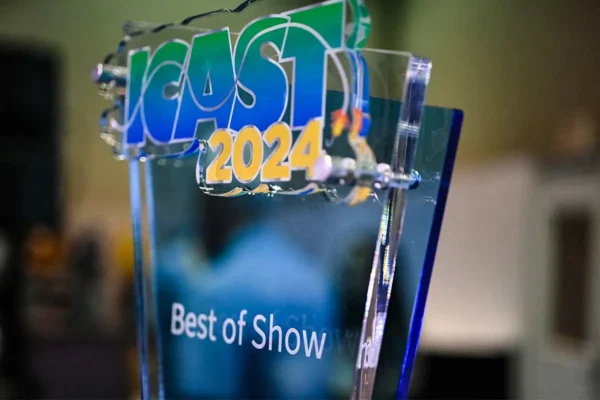If you’ve been in the exhibiting game for a while, you’ve probably tried most of the old-school, in-booth promotions, those ubiquitous tradeshow entertainments such as miniature putting greens, prize wheels, treasure chests and bucket tosses.
While amusing, they don’t have nearly enough pizzazz to dare Gen X and Gen Y attendees to engage with your brand. But today’s breed of interactive games do by enlisting not only attendees’ muscles but also their minds.
Innovative entertainment suppliers like, Amusitronix, Interactive Entertainment Group, Plan>It Interactive and Traffic Builders, are reinventing the in-booth game to attract and engage new generations of tradeshow attendees. These companies are modernizing games by incorporating touch screen, virtual reality, 3-D and other interactive technologies.
Better news yet, exhibitors can custom-brand attendees’ game-playing experiences at highly affordable prices.
“Everybody has a competitor in them. Everybody wants to be the best, and interactive games can make the dream come true,” said Steve Breitner, director of sales for Toronto-based Global Interactive Events (GIE).
Traditional in-booth games, while catering to show-goers’ innate competitiveness, do little to hold attendees’ attention and involve them with a brand. That’s because they’re designed to present low-skill challenges.
“Spinning a wheel doesn’t involve a lot of skill,” said Breitner. “Taking a mind-test is something else again.”
GIE, a licensee of Carlsbad, California-based NTN Buzztime, which produces game stations for the hospitality industry, adapts bar-top game hardware for use at tradeshows, conferences and corporate events. The adaptations challenge attendees to answer trivia questions in order to win.
The product GIE provides clients consists of custom software-driven games that attendees play using handheld wireless touchpads. The touchpads are connected to a base station that allows the interactivity.
An exhibitor first supplies GIE’s developers a list of brand-specific questions to ensure that the game’s content ties into its marketing message. Game scripts can include only the exhibitor’s questions or can comprise a mix of general-knowledge and brand-specific questions. To help exhibitors, GIE maintains a database of well-tested trivia questions that can be used in any script.
One of the smartest things Breitner has seen exhibitors do is include marketing research questions in a game. Any resistance to participating in a survey on the part of attendees melts away. But no matter what kind of questions are included, game scripts should remain brief. Interactive games with lengthy scripts tend to backfire. Players get too caught up in the game and begin blocking traffic.
“We advise exhibitors to keep the trivia questions short and limit them to no more than five,” said Breitner. “You always want to keep people moving. You want them to finish quickly, pick up their prize trinket and then walk into your booth so you can begin to work them as the next players are lining up.”
After supplying its questions, the exhibitor provides GIE with its logo and booth graphics. The firm uses those to tailor the game’s user interface and produce a branded keypad overlay for each touchpad.
“From the standpoint of content and branding, the game becomes 100 percent the exhibitor’s,” said Breitner.
The total costs are reasonable. A fully customized interactive game from GIE begins at around $2,500 and runs up to $6,000, depending on such factors as the length of the tradeshow and the number of bay stations and touchpads required.
Intellectual dare isn’t the only appeal the new breed of games has for attendees. The games’ multi-player feature is a crucial aspect of their popularity, according to Breitner.
“Camaraderie drives attendees’ interest as much as competition,” he said. “Most attendees want to compete against other players, not play a game by themselves.”
To enable multi-player action, an exhibitor will rent as many as 10 touchpads for each bay station in its booth.
With that level of investment, it’s important to give prominence to the area of the booth where the game will be played, positioning it in the front and center and as close to the aisle as permissible.
It’s also important to organize each round of play. To that end, Breitner recommends that exhibitors assign the role of “game host” to an affable staff member. The host’s job is to coach participants, congratulate winners and whip up a lot of excitement.
“The host’s role is to break the ice and egg players along, so everyone has just a little more fun,” said Breitner.
Bob James is vice president of marketing for ITN International, an event analytics company known for pioneering the use of NFC (short-range wireless) within the exhibitions industry. With operations in China, France, the UK and the US, ITN International provides exhibitors — more than 150,000 of them — with innovative lead-management solutions based on NFC.






























